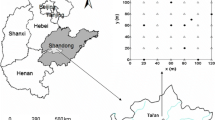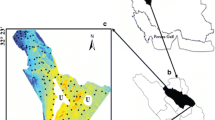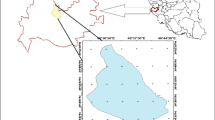Abstract
In the current study, Thematic Mapper image was compiled along with field and laboratory investigation results to map the Pliocene clay deposits. These deposits have high swelling potential; consequently they will have a negative impact on the urbanization expansion surrounding the flood plain zone (Low desert zone) in Egypt. Principle Component and Minimum Noise Fraction techniques with the help of supervised classification were successful in the mapping of these deposits. The interpretation shows that the Pliocene clay deposits occupy most of the wadis terraces and part of the wadis floors, and sometimes they covered by Quaternary deposits (1–5 m of sand and gravel). The physio-chemical characteristics of these deposits indicate that the Pliocene clay ranges from silty clay to clay with small amounts of sand. Laboratory analysis (Atterberg limits, saturation degree, and cation exchange capacity) indicate the swelling characteristics of the Pliocene clay. Different classification systems were applied and all reveal the expansive nature of this soil, which should be taken into account for future development in the area.







Similar content being viewed by others
References
Aiban SA, Al-Abdul Wahhab HI, Al-Amoudi OSB, Ahmed HR (1998) Performance of a stabilized marl base: a case study. Construct Build Mater 12(6–7):329–340
American Society for Testing Materials (1993) Annual book of ASTM standards. Construction. Section 4. Soil and rock; dimension stone; geosynthesis, vol 04.08. ASTM, Philadelphia
Anderson JU, Kamal EF, O’Connor GA (1973) Factors affecting the coefficient of linear extensibility in vertisols. Soil Sci Soc Am Proc 37:298–299
Azam S (2006) Large-scale odometer for assessing swelling and consolidation behaviour of Al-Qatif clay. In: Al- Rawas AA, Goosen MFA (eds) Expansive soils: recent advances in characterization and treatment. Balkema Publishers-Taylor and Francis, The Netherlands, pp 85–99
Bittick SM, Morgan KM, Busbey AB (1994) Preliminary spectral analysis of calibrated reflectance patterns to map the distribution of alluvial fans on the Rosillos laccolith in Brewster County, Texas. Proceeding 10th thematic conference on geologic remote sensing, San Antonio, Texas, 9–12 May (Ann, Arbor, MI: ERIM), pp 151–157
Black CA (1965) Methods of soil analyses Part 1. Physical and mineralogical properties. American Society Agronomy, Inc. Pub, Madison, USA
Boardman JW, Kruse FA (1994) Automated spectral analysis: a geological example using AVIRIS data, northern Grapevine Mountains, Nevada. Proceeding 10th thematic conference on geologic remote sensing, San Antonio, Texas, 9–12 May, pp 407–418
Carroll D (1970) Clay minerals: a guide to their X-ray identification. Geol Soc of America Special Paper 128. Geological Society of America, Boulder, Colorado
Carter M, Bentley SP (1991) Correlations of soil properties. Pentech Press, London, UK
Chabrillat S, Goetz AFH, Krosley L, Olsen HW (2002) Use of hyperspectral images in the identification and mapping of expansive clay soils and the role of spatial resolution. Remote Sens Environ 82:431–445
Chen FH (1988) Foundations on expansive soils. Elsiveir, USA
Crosta AP, Moore JMcM (1989) Enhancement of Landsat Thematic Mapper imagery for residual soil mapping in SW Minas Gerais State, Brazil: a prospecting case history in Greenstone Belt terrain. Proceedings of the Seventh Thematic Conference on Remote Sensing for Exploration Geology, Calgary, Alberta, Canada, 2–6 October, pp 1173–1187
Dawson RF (1953) Movement of small houses erected on an expansive clay soil. Proc 3rd Intl Conf Soil Mech Found Eng 1:346–350
Ferguson G (1993) Use of self-cementing fly ashes as a soil stabilization agent. In Sharp KD (eds) Fly ash for soil improvement. p 1–14. Am Soc Civil Eng Geotech Pub 36
Gee GW, Bauder JW (1986) Particle-size analysis. In: Klute A (ed) Methods of soil analysis, Part 1, 2nd edn. ASA and SSSA, Madison, pp 383–411 Agron. Monogr. 9
Gill WR, Reaves CA (1957) Relationships of Atterberg limits and cation exchange capacity to some physical properties of soil. Soil Sci Soc Am Proc 21:491–494
Goetz AFH, Rowan LC (1981) Geologic remote sensing. Science 211:781–791
Green AA, Berman M, Switzer P, Craig MD (1988) A transformation for ordering multispectral data in terms of image quality with implications for noise removal. IEEE Trans Geosci Remote Sens 26(1):65–74
Hamberg DJ (1985) A simplified method for predicting heave in expansive soils. M.S. thesis, Colorado State University, Fort Collins, CO, USA
Head KH (1992) Manual of soil laboratory testing, vol. I, Soil classification and compaction tests. Pentech Press, London
Holt JH (1969) A study of physico-chemical, mineralogical and engineering index properties of fine grained soils in relation to their expansive characteristics. Ph.D. Dissertation, Texas A&M Univ., College Station, TX
Holtz WG, Gibbs HJ (1956) Engineering properties of expansive clays. Trans ASCE 121:641–677
Ishida T, Ando H (1999) Use of disjunctive cokriging to estimate soil organic matter from Landsat Thematic Mapper image. Int J Remote Sens 20(8):1549–1565
Jackson ML (1975) Soil chemical analyses advanced course. Pub. By author, Madison
Karathanasis AD, Hajek BF (1985) Shrink-swell potential of montmorillonitic soils in udic moisture regimes. Soil Sci Soc Am J 49:159–166
Lambe TW (1960) The character and identification of expansive fed. Housing Admin. Rep. 701. U.S. Gov. Print. Office, Washington, DC
MacEwan DMC, Wilson MJ (1980) Interlayer and intercalation complexes of clay minerals. In: Brindley GW, Brown G (eds) Crystal structures of clay minerals and their X-ray identification, chapter 3. Monograph 5 of Mineralogical Society, London
McKeen RG, Hamberg DJ (1981) Characterization of expansive soils. Transportation. Research. Record. 790, Transportation. Research Board, USA
Nelson JD, Miller DJ (1992) Expansive soils: problem and practice in foundation and pavement engineering. John Wiley & Sons, New York
Parker JC, Amos DF, Kaster DL (1977) An evaluation of several methods of estimating soil volume change. Soil Soc Am J 41:1059–1064
Pearring JR (1963) A study of basic mineralogical, physical-chemical, and engineering index properties of laterite soils. Ph.D. Dissertation, Texas A&M Univ., College Station, TX, USA
Riaza A, Mediavilla R, Santistieban JI (2000) Mapping geological stages of climate-dependent iron and clay weathering alteration on lithologically uniform sedimentary units using Thematic Mapper imagery (Tertiary Duero Basin, Spain). Int J Remote Sens 21(5):937–950
Ruiz-Armenta JR, Prol-Ledesma RM (1998) Techniques for enhancing the spectral response of hydrothermal alteration minerals in Thematic Mapper images of Central Mexico. Int J Remote Sens 19(10):1981–2000
Schafer WM, Singer MJ (1976) Influence of physical and mineralogical properties on swelling of soils in Yolo County, California. Soil Sci Soc Am J 40:557–562
Seed HB, Woodward RJ Jr, Lundgren R (1962) Prediction of swelling potential for compacted clays. J Soil Mech Found Div Am Soc Civil Eng 88(SM3):53–87
Skempton AW (1953) The colloidal activity of clay. In: Proceedings of the third international conference on soil mechanics and foundation engineering vol. I, London, pp 57–61
Snethen DR (1980) Characterization of expansive soils using soil suction data 4th international conference on expansive soil, pp 54–75
Snethen DR, Johnson LD, Patrick DM (1977) An evaluation of expedient methodology for identification of potentially expansive soils. Soil and Pavements Laboratory, U.S.Army Eng. Waterway Exp. Sta., Vicksburg, MS, Rep. No. FHWA-RE-77-94, NTIS PB-289-164
Thomas GW (1982) Exchangeable cations. In: Page AL (ed) Methods of soil analysis, Part 2, 2nd edn. ASA and SSSA, Madison, pp 159–165, Agron Monogr 9
Thomas PJ, Baker JC, Zelazny LW (2000) An expansive soil index for predicting shrink-swell potential. Soil Sci Soc Am J 64:268–274
Weed SB (1977) Minerals in soil environment. Soil Sci Soc Am J 56:1640–1645
Author information
Authors and Affiliations
Corresponding author
Rights and permissions
About this article
Cite this article
Youssef, A.M. Mapping the Pliocene Clay Deposits Using Remote Sensing and its Impact on the Urbanization Developments in Egypt: Case Study, East Sohag Area. Geotech Geol Eng 26, 579–591 (2008). https://doi.org/10.1007/s10706-008-9191-6
Received:
Accepted:
Published:
Issue Date:
DOI: https://doi.org/10.1007/s10706-008-9191-6




